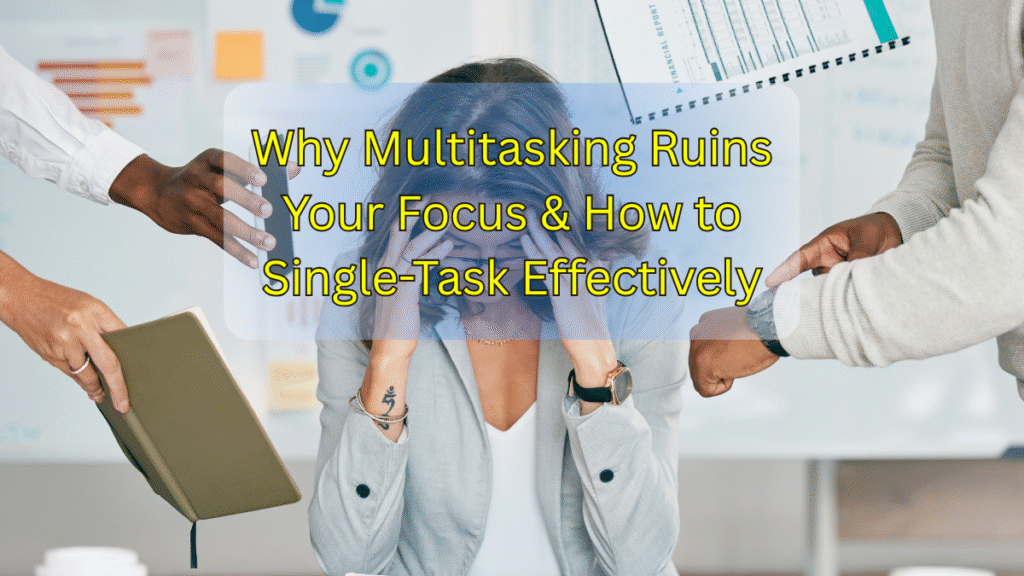Multitasking Ruins Your Focus
We live in a world that glorifies busyness. Juggling emails while on a Zoom call, scrolling through social media while “watching” a movie, or trying to write a report while intermittently checking Slack—sound familiar? Multitasking has become a badge of honor, a supposed mark of productivity. But here’s the truth: multitasking is a myth. Worse, it’s sabotaging your focus, efficiency, and even your mental well-being.
In this post, we’ll explore why multitasking doesn’t work, how it harms your brain, and—most importantly—how to reclaim your focus by mastering the art of single-tasking.

The Myth of Multitasking: Why Your Brain Can’t Handle It
Contrary to popular belief, our brains aren’t wired to handle multiple complex tasks at once. What we call “multitasking” is actually task-switching—rapidly shifting attention from one thing to another. And each switch comes at a cost.
1. Multitasking Slows You Down
Research from Stanford University shows that heavy multitaskers are less productive than those who focus on one task at a time. Every time you switch tasks, your brain spends precious milliseconds (or even seconds) reorienting itself. Over time, these tiny delays add up, making you slower overall.
2. It Increases Mistakes
When your attention is divided, errors creep in. A study published in the Journal of Experimental Psychology found that people who multitask make up to 50% more mistakes than those who concentrate on a single task.
3. It Drains Mental Energy
Jumping between tasks exhausts your brain. Think of it like a computer running too many programs at once—eventually, it overheats and slows down. Constant task-switching leads to mental fatigue, making it harder to focus even when you want to.
4. It Kills Deep Work
Cal Newport, author of Deep Work, argues that meaningful, high-quality output requires uninterrupted concentration. Multitasking fractures your attention, preventing you from entering a state of “flow,” where creativity and productivity thrive.
Video Credits
How to Break the Multitasking Habit & Master Single-Tasking
Now that we know multitasking is more harmful than helpful, how do we retrain our brains to single-task effectively? Here are practical strategies:
1. Prioritize Ruthlessly
Not all tasks are equal. Use the Eisenhower Matrix to categorize tasks by urgency and importance. Focus on one high-priority task at a time instead of splitting attention across multiple low-value activities.
2. Time Blocking > To-Do Lists
Instead of a chaotic to-do list, schedule dedicated time blocks for each task. For example:
- 9:00–10:30 AM: Write report (no distractions)
- 10:30–11:00 AM: Check emails
This method keeps you accountable and minimizes task-switching.
3. Eliminate Digital Distractions
- Turn off notifications (yes, all of them).
- Use apps like Freedom or Focus@Will to block distracting websites.
- Try the Pomodoro Technique (25 minutes of focus, 5-minute break).
4. Practice Mindfulness & Mono-Tasking
Train your brain to focus on one thing at a time. Start small:
- Eat without scrolling.
- Listen fully in conversations (no half-hearted “uh-huhs”).
- Work in a distraction-free environment.
5. Batch Similar Tasks
Group related activities (e.g., replying to emails, making calls) into designated time slots. This reduces cognitive load compared to constantly switching between unrelated tasks.
The Benefits of Single-Tasking
When you commit to single-tasking, you’ll experience:
✅ Higher-quality work (fewer mistakes, deeper thinking)
✅ Faster completion times (no wasted energy on switching)
✅ Less stress (mental clutter decreases)
✅ Improved memory & learning (focused attention enhances retention)
Final Thoughts: Embrace the Power of One Thing at a Time
Multitasking might feel productive, but it’s an illusion. True efficiency comes from focused, intentional work. Start small—pick one task today and give it your full attention. Over time, single-tasking will become second nature, and you’ll wonder how you ever survived the chaos of constant switching.
Your turn: What’s one task you’ll commit to doing without distractions today? Share in the comments below! And if you found this post helpful, consider subscribing for more productivity tips.











